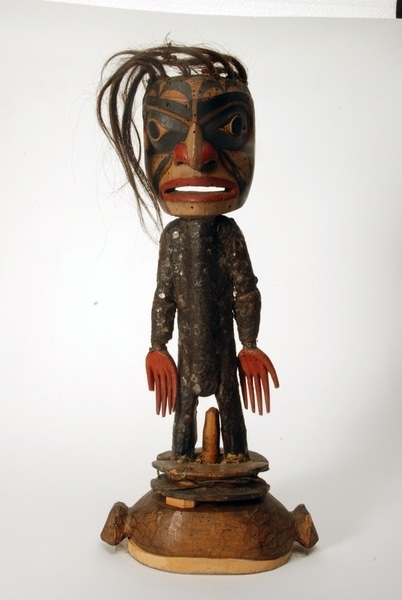Figure Item Number: Z 14856 from the MAA: University of Cambridge









Description
Carved and painted wooden figure, the body encrusted with mica flakes. Rests on a pivot which allows it to rotate. The face has been painted with red nostrils and mouth, black eyebrows, and has U-form decorations on the forehead. The hands are also painted red, and are carved with long fingers.; Good
Context
According to Dr George MacDonald, of the Canadian Museum of Civilisation, the figure could be Shining Boy , an incarnation of Raven. He also thought that the figure could be Tsimshian, rather than Haida, as originally described (1994). Catalogue card notes a label says Haida, 11 06 1931. The original European tribal names and, where possible, current tribal names have both been given in separate GLT fields.; Catalogue card suggests the figure was from a headdress. The figure was probably a shaman' s spirit helper and was manipulated during shamanic rituals. The spirit helpers are characterised by unkempt hair and a wild vitality reminiscent of the shamans themselves.Illness was thought to be brought about by malevolent supernatural beings who stole the souls of their victims and cast harmful spells. The Northwest Coast shaman sought to restore the social order disrupted by the supernaturally caused illness. The shaman resorted to supernatural remedies and manipulated his power through a variety of paraphernalia, such as rattles, spirit figures (1885.66.16) and masks (E 1911.25 26), and soul catchers (1885.66.22) in order to retrieve the lost human soul.; Exhibited: Old anthropological displays at CUMAA, Maudslay Gallery case 36, no.3, dismantled 081986.Exhibited: On display at MAA, Maudslay Hall, Northwest Coast case, no. 22, 1990 6 November 2010.
Item History
- Made in British Columbia, Canada
- Received from Edmund Hope Verney, Harry Geoffrey Beasley and Irene Marguerite Beasley
What
Who
- Culture
- Tsimshian
- Received from
- Edmund Hope Verney, Harry Geoffrey Beasley and Irene Marguerite Beasley
Where
- Holding Institution
- MAA: University of Cambridge
- Made in
- British Columbia, Canada
Other
- Keyword
- Ceremonial Objects; Magic and Religion